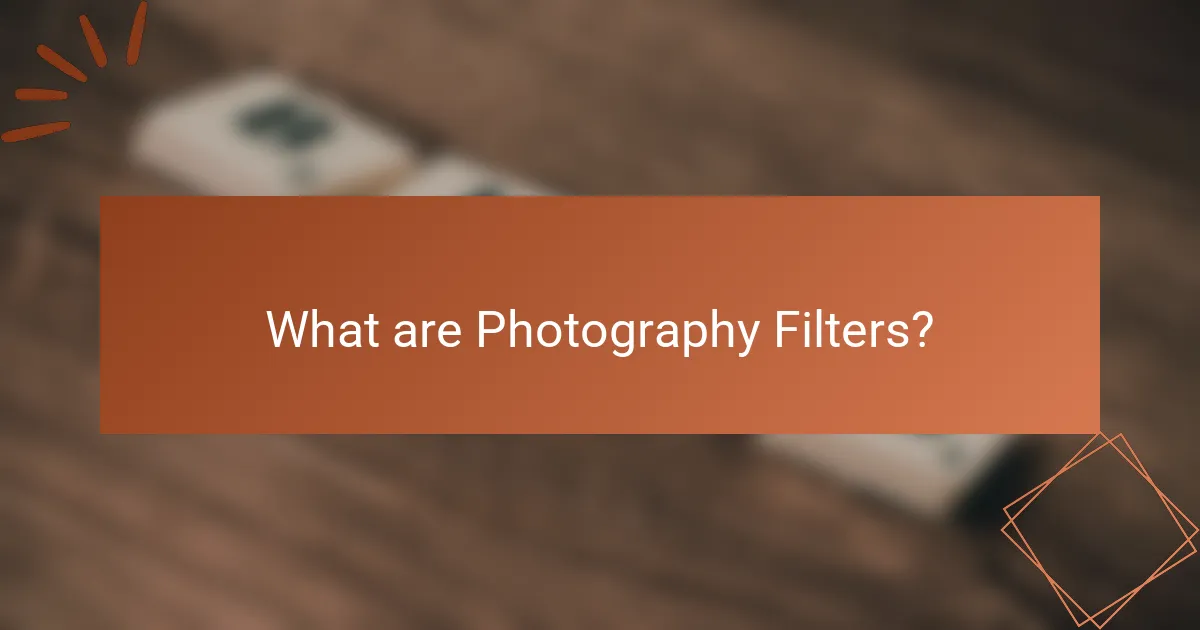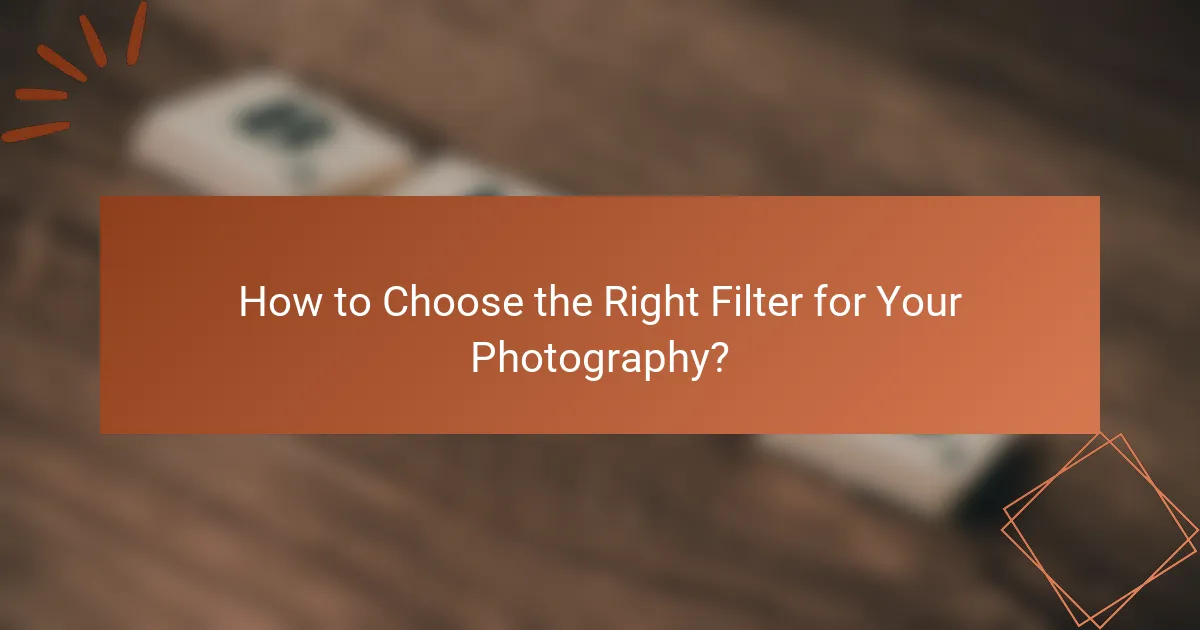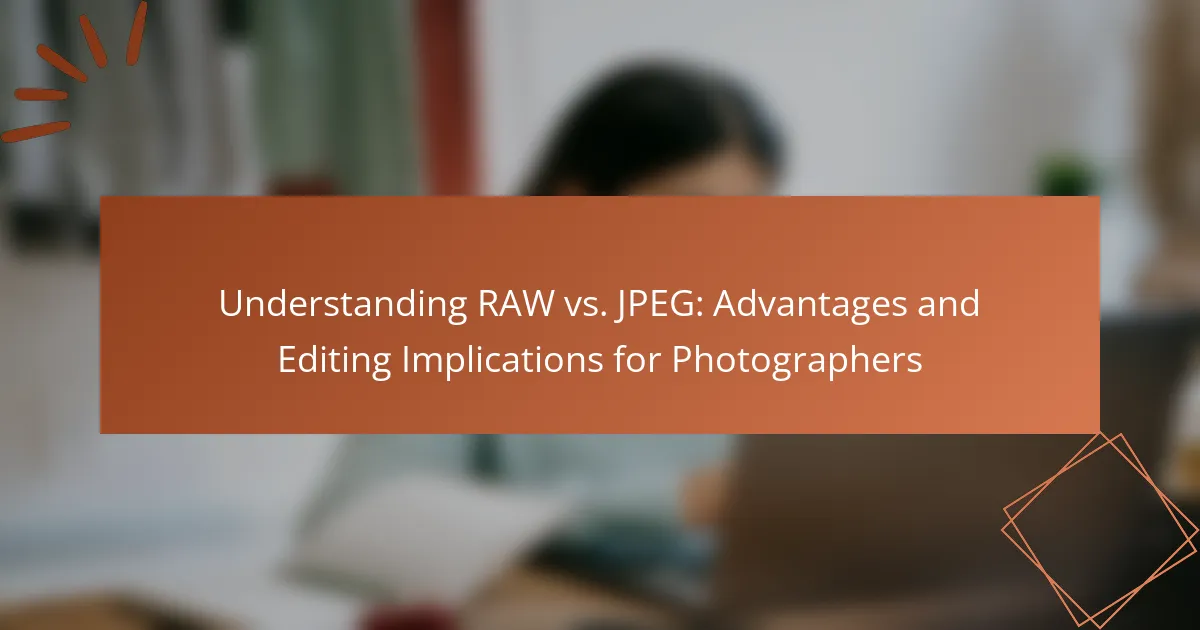Photography filters are transparent or translucent materials used in front of a camera lens to modify light for specific effects. This article explores various types of filters, including polarizing filters that enhance colors and reduce glare, neutral density filters that limit light for longer exposures, and graduated filters that balance exposure in scenes with different lighting. It also covers the selection process for filters based on photography needs, such as landscape or portrait shots, and emphasizes the importance of filter quality and proper attachment to avoid image degradation. Additionally, practical techniques for using filters effectively in various lighting conditions are discussed, highlighting their significant impact on image quality.

What are Photography Filters?
Photography filters are transparent or translucent materials placed in front of a camera lens. They modify the light entering the camera to achieve specific effects. Common types include polarizing filters, which reduce glare and enhance colors. Neutral density filters limit light without affecting color, allowing for longer exposures. Graduated filters transition from clear to tinted, balancing exposure in scenes with varied lighting. Filters can also protect lenses from scratches and dust. Their use dates back to the early days of photography, demonstrating their longstanding importance in the field.
How do Photography Filters Enhance Images?
Photography filters enhance images by modifying light before it reaches the camera sensor. They can improve color saturation, reduce glare, and add special effects. For instance, polarizing filters reduce reflections from surfaces like water or glass. This results in clearer images with more vibrant colors. Neutral density filters limit the amount of light entering the lens. This allows for longer exposure times without overexposing the image. Graduated filters help balance exposure between bright and dark areas in a scene. This technique is especially useful in landscape photography. Filters can also enhance contrast and sharpness, contributing to overall image quality.
What Types of Effects Can Filters Produce?
Filters can produce various effects in photography. Common effects include color enhancement, contrast improvement, and glare reduction. Polarizing filters reduce reflections and increase color saturation. Neutral density filters allow longer exposures without overexposing the image. Graduated filters balance exposure between the sky and the foreground. UV filters protect the lens and can slightly reduce haze. Each type of filter serves a specific purpose to enhance the final image quality.
How Do Filters Influence Color and Contrast?
Filters modify the light entering the camera, which directly influences color and contrast. They can enhance or reduce specific wavelengths of light. For example, a polarizing filter reduces glare and increases color saturation. This results in more vivid skies and foliage. Neutral density filters limit light without altering color balance. This allows for longer exposures, enhancing contrast in dynamic scenes. Color filters can change the overall hue of an image. They are often used in black and white photography to add depth and contrast. The use of filters can significantly affect the mood and visual impact of a photograph.
What Are the Different Types of Photography Filters?
The different types of photography filters include UV filters, polarizing filters, neutral density filters, and graduated filters. UV filters protect the lens and reduce UV light, which can cause haziness in images. Polarizing filters enhance colors and reduce reflections from surfaces like water and glass. Neutral density filters reduce the amount of light entering the lens, allowing for longer exposure times without overexposing the image. Graduated filters transition from clear to dark, helping to balance exposure between the sky and the land in landscape photography. Each filter serves a specific purpose to enhance image quality and achieve desired effects.
What is a Polarizing Filter and How is it Used?
A polarizing filter is a photography accessory that reduces reflections and enhances colors. It works by filtering out polarized light, which is often reflected off surfaces like water and glass. This filter can be rotated to adjust the level of polarization. When used correctly, it increases contrast in skies and makes clouds stand out. Photographers often use it to improve the saturation of foliage and landscapes. The effect is particularly noticeable in bright sunlight. A polarizing filter is essential for outdoor photography. It can also help reduce haze in distant landscapes.
What is a Neutral Density Filter and Its Applications?
A Neutral Density (ND) filter is a photographic filter that reduces the intensity of light entering the lens without altering the color of the scene. ND filters allow photographers to use wider apertures or slower shutter speeds in bright lighting conditions. This capability is essential for achieving desired effects such as shallow depth of field or motion blur. For example, using an ND filter can enable a photographer to blur the movement of water in a waterfall shot while maintaining proper exposure. ND filters come in various strengths, measured in stops, to control the amount of light reduction. Common applications include landscape photography, long exposure shots, and video recording to prevent overexposure.
What is a Graduated Filter and When Should You Use It?
A graduated filter is a photographic filter that transitions from opaque to transparent. It is primarily used to balance exposure in scenes with a significant difference in brightness, such as landscapes. Photographers often use graduated filters to darken skies while keeping the foreground correctly exposed. This technique helps to prevent overexposure in bright areas and underexposure in darker areas. Graduated filters come in various strengths and color tints, allowing for creative adjustments. They are particularly effective during sunrise and sunset when light conditions fluctuate rapidly. Using graduated filters can enhance the overall dynamic range of an image, resulting in more visually appealing photographs.
What is a UV Filter and Does It Still Have Value?
A UV filter is a transparent optical filter that blocks ultraviolet light. It was traditionally used to protect camera lenses and reduce haze in photographs. Although modern digital sensors are less sensitive to UV light, UV filters still offer value. They provide a physical barrier against dust, scratches, and moisture. Many photographers continue to use UV filters for lens protection. According to a survey by the Professional Photographers of America, over 70% of professional photographers use UV filters for this purpose. Thus, UV filters retain their value in photography today.

How to Choose the Right Filter for Your Photography?
To choose the right filter for your photography, first identify the purpose of the filter. Different filters serve distinct functions, such as reducing glare or enhancing colors. For landscape photography, a polarizing filter can reduce reflections and increase saturation. If you’re shooting in bright conditions, a neutral density filter can help manage exposure. Consider the lens size when selecting a filter to ensure proper fit. Additionally, evaluate the filter’s optical quality, as lower-quality filters can degrade image clarity. Research indicates that filters can significantly impact image quality, making informed choices essential for desired outcomes.
What Factors Should You Consider When Selecting a Filter?
When selecting a filter, consider the type of photography you will be doing. Different filters serve specific purposes, such as polarizing filters for reducing glare or ND filters for controlling exposure. Assess the filter’s optical quality, as higher quality filters minimize distortion and color shifts. Compatibility with your lens size is crucial; ensure the filter fits securely on your lens. Evaluate the filter material; glass filters typically offer better image quality than plastic ones. Think about the filter’s ease of use, especially if you plan to change filters frequently. Finally, check for any additional features, such as scratch resistance or multi-coating, which can enhance durability and performance.
How Do Filter Sizes and Mounting Options Affect Your Choice?
Filter sizes and mounting options significantly influence your filter choice. The size of a filter determines its compatibility with your lens. Common filter sizes include 49mm, 52mm, 58mm, and 77mm. Using the correct size ensures proper fit and prevents vignetting. Mounting options refer to how filters attach to the lens. Threaded filters screw onto the lens filter thread. Slip-on filters require a specific lens diameter. Adapter rings can be used to fit different sizes. These options affect versatility and convenience. For example, a 77mm filter can be used on multiple lenses with step-up rings. Thus, understanding sizes and mounting options is crucial for effective filter use in photography.
What Budget Considerations Should You Keep in Mind?
When budgeting for photography filters, consider the cost of the filters themselves. High-quality filters typically range from $30 to $300, depending on the type and brand. Additionally, factor in the cost of compatible filter holders or adapters, which may add another $20 to $100.
Don’t forget to account for potential shipping costs and taxes, which can vary based on location. Maintenance costs, like cleaning solutions and cloths, should also be included in your budget.
Lastly, consider the long-term investment in filters, as they can enhance image quality and longevity. Investing in quality filters can save money on post-processing and improve your overall photography experience.
What Techniques Can Enhance Your Use of Filters?
Using filters effectively in photography can be enhanced through several techniques. First, understanding the type of filter you are using is crucial. For example, polarizing filters reduce reflections and enhance colors. Second, adjusting the angle of the filter can optimize its effect on light. Third, experimenting with exposure settings while using filters can yield better results. Fourth, combining multiple filters can create unique effects, but be cautious of vignetting. Fifth, using a tripod helps maintain stability when longer exposures are necessary with filters. Lastly, practicing in different lighting conditions allows you to see how filters interact with various environments. These techniques collectively improve filter usage in photography.
How Can You Properly Position Filters for Optimal Results?
To properly position filters for optimal results, align the filter directly in front of the lens. Ensure the filter is clean to avoid unwanted reflections. Rotate polarizing filters to achieve desired effects, such as reducing glare. Position neutral density filters to manage exposure without altering color. Use graduated filters to balance exposure between sky and land. Secure filters tightly to prevent light leaks. Check for vignetting by reviewing images at various angles. Adjust the filter position based on lighting conditions for best outcomes.
What Are Common Mistakes to Avoid When Using Filters?
Common mistakes to avoid when using filters include using the wrong type of filter for the situation. For example, a polarizing filter is ineffective in low-light conditions. Another mistake is neglecting to check for vignetting, which can occur with wide-angle lenses and certain filters. Additionally, not adjusting exposure settings after adding a filter can lead to overexposed or underexposed images. Failing to clean filters regularly can result in unwanted spots or haze in photographs. Lastly, some photographers forget to consider the impact of filters on color balance, which can distort the final image.

What Practical Tips Can Help You Utilize Filters Effectively?
To utilize filters effectively in photography, start by selecting the right filter for your subject. For landscapes, use a polarizing filter to enhance colors and reduce glare. For portraits, a soft focus filter can create a dreamy effect. Next, ensure proper attachment to the lens to avoid vignetting. Check the exposure settings, as filters can reduce light entering the lens. Experiment with different angles to see how the filter affects the scene. Regularly clean your filters to maintain image clarity. Lastly, practice using filters in various lighting conditions to understand their impact on your photos.
How Can You Experiment with Different Filters to Improve Your Skills?
Experimenting with different filters can significantly enhance your photography skills. Start by selecting various filters, such as polarizers, ND filters, or color filters. Each filter alters the light entering the lens, affecting the final image. For instance, a polarizing filter reduces glare and enhances colors. An ND filter allows for longer exposure times, creating motion blur in moving subjects.
Capture the same scene using different filters to observe the effects. This practice helps in understanding how each filter impacts exposure, contrast, and color saturation. Review the images to analyze the differences. Adjust your technique based on these observations.
Consistent experimentation with filters can lead to improved decision-making in future shoots. It allows photographers to develop a personal style and understand creative possibilities.
What Best Practices Should You Follow When Using Filters?
Use filters effectively by understanding their purpose and characteristics. Choose the right filter for your specific photography needs. For example, polarizing filters reduce glare and enhance colors. Always check for vignetting, especially with wide-angle lenses. Clean filters regularly to avoid image degradation. Experiment with different filters to see their effects on exposure and color balance. Use a tripod when using filters to maintain stability and sharpness. Lastly, consider the light conditions; some filters perform better in certain lighting. These practices enhance image quality and creativity in photography.
Photography filters are essential tools that modify light entering a camera lens to enhance image quality and achieve specific effects. The article covers various types of filters, including polarizing, neutral density, graduated, and UV filters, detailing their functions and applications in photography. It discusses how filters influence color, contrast, and exposure, while providing practical tips for selecting and using filters effectively. Additionally, common mistakes and best practices are outlined to help photographers maximize the benefits of filters in their work.



